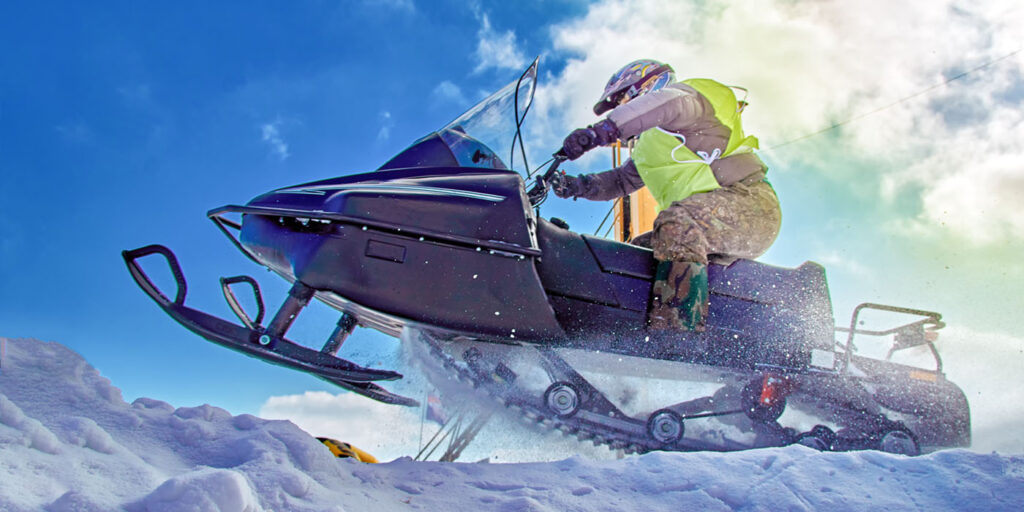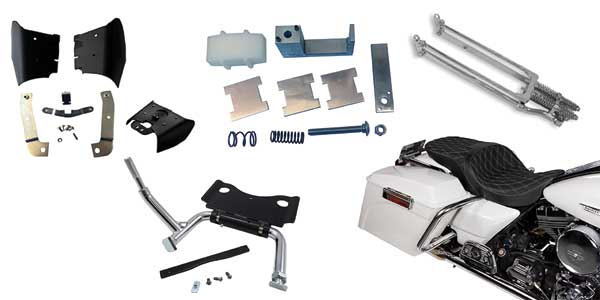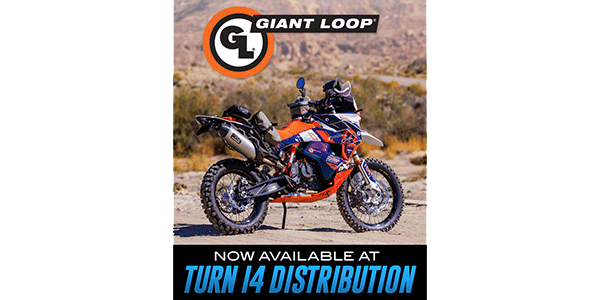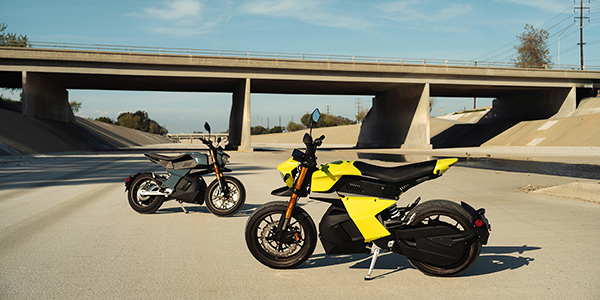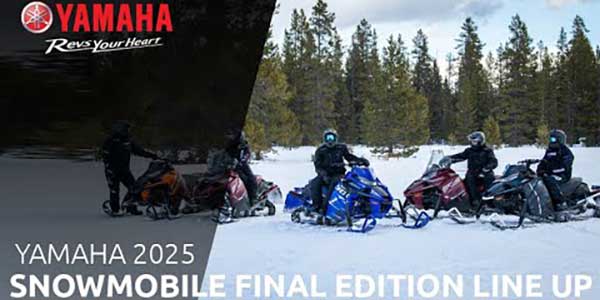Last week, we published an article from Arctic Cat about how to help customers find the right snowmobiles for them, looking at everything from the buyer’s preferred terrain to his or her ability level in order to determine the proper engine and chassis size.
Now, while it’s no secret that stock snowmobiles are getting more advanced as the years go by, there will always be opportunities to enhance them and the rider’s experience. Let’s take a look at the various accessories that can enhance snowmobile performance, protection, rider comfort and storage capabilities.
Performance
Aside from the typical performance upgrades one might make for any powersport vehicle – exhaust, turbo kits and suspension tweaks, to name a few — there are a few snowmobile-specific enhancers that customers enjoy.
Snow flaps are one such accessory. While riders may assume snow flaps are only used to keep snow from flying back onto any riders traveling behind them, flaps actually serve a performance purpose as well: keeping the engine cool by diverting snow back up the tunnel.
Other snowmobile performance accessories have to do less with internal components and more with external factors. For any land-based powersport vehicle, gaining traction on a variety of terrain is critical. However, unlike motorcycles, ATVs or UTVs, snowmobiles don’t have tires to do that job. A snowmobile’s track takes on the majority of that task, but sometimes it needs a little help, since the height of snowfall varies all season. As such, other popular modification items are studs, according to Tim Piver, brand sales director for FLY Racing Street, Snow and Watercraft; HIGHWAY 21; GMAX, SP1; and UCLEAR at Western Power Sports.
“Studs are metal grip items that go into a track,” Piver explains. “Now, when you’re talking about the Midwest or up north, you’re talking about the tracks having different lug heights, and the lug allows them to move through the snow as the track spins. If the lug is shorter, like in the Midwest, where the snow is more compact and you’re primarily riding a trail system of some type, it gets icy. Without having that extra traction of a steel stud embedded in the track, the track can just sit there and spin.”
But studs aren’t just for trail riders, Piver notes; mountain racers will often also use them as well — just in different sizes compared to their trail-riding counterparts.
And when we’re talking about traction, we can’t forget about wear guards and carbides. These items dig into ice and hard-packed snow to make steering a snowmobile easier and to prevent rushing and zig-zagging. Wear bars and carbides are like ice skates for snowmobiles. These sharp surfaces are attached to the bottom of the sled’s skis. The main difference between the two is in the makeup. Wear bars are made of steel and generally come stock on a snowmobile. Carbides are made of carbide steel and are thus more durable and longer-lasting than wear bars. However, wear bars are perfectly suitable options for amateur riders, whereas carbides are more apt for true enthusiasts and racers who plan to tear up the tracks and slopes.
Studs and carbides are the two biggest wear items on a snowmobile, Piver asserts, especially when you’re in the Midwest and doing a lot of trail miles. “You could do three or four trips and have to replace studs and then your carbides, depending on the surface you’re on. They start out nice and sharp, but they do wear down,” he says.
Protection
There are two types of protective equipment for snowmobiles: the type that protects the sled itself and the type the protects everything else from the sled.
Even with lugs, studs and carbides helping a rider gain traction, snow is still slippery, and chances are that person is going to slide somewhere unintended at some point. With trees, scrubs, rocks and ice being the major “roadblocks,” so to speak, the best accessories for protecting a snowmobile come in the form of bumpers and skid plates. Some varieties of bumpers even come combined with a skid plate to help protect the front of the machine from impact.
Bumpers aren’t just for the front though. There are also rear ones that offer enhanced tunnel strength, rigidity and protection while also serving as a means to lift a sled when it gets stuck in the snow.
Another popular protective accessory is a cover. Covers keep snowy buildup from adhering to a snowmobile, so riders don’t have to brush off a bunch of snow or chip off a block of ice before riding — a huge time and energy saver. Nowadays, many people also opt to get their snowmobiles wrapped to give them some added protection, and there are special cleaners riders can use even in the cold to keep those wraps looking good.
Now that we’ve seen what can protect a snowmobile, let’s look at how to keep one from tearing up surfaces that aren’t snow and ice. Whether customers put their sleds in truck beds or onto trailers, they’re going to have to haul them somewhere, and those lugs, studs and carbides that are so good at digging into snow will also dig into the coatings and paint jobs on their transports if they’re not careful. In fact, many new snowmobilers get home from a purchase only to realize that they failed to get the proper equipment to keep those new sleds from tearing up their transport beds. In addition, they usually find that they also can’t get traction on the ice when trying to unload or load them.
Piver notes that while plastic runners will keep the carbides from tearing up a transport’s surface, some of the best-selling accessories have to do with moving the snowmobile itself such as movers or dollies, racks, ramps, traction plates, traction mats and guides for the skis. “Snowmobiles are heavy and not easy to move around when inside a garage or shop,” he says. “These items are really big sellers that people sometimes aren’t aware they need yet if they are just getting into the sport.”
Comfort
Comfort is a major concern for snowmobilers. If they have to be out in the cold for hours while enjoying this sport, they might as well make the best of it!
As with motorcycles, handlebars and risers are some of the major accessories riders buy, since a stock set can cause arm fatigue for customers of differing heights and riding positions. “Handlebars can change the angle of operation and allow for the rider to customize their stance to be more or less aggressive, while risers can change the handlebar height for comfort and increased performance,” says Aaron Wallace, associate marketing manager for Pro Armor.
Hands also deserve some special treatment on a snowmobile, especially because they’re prone to get stiff in such cold temperatures, even with gloves on. Heated grips, therefore, are pretty crucial for riders. In addition, Piver notes, thumb throttles have also gotten heaters in the last five to 10 years. “There are billet thumb throttle blocks that have better heaters. Even though you have grip heaters that are pretty standard on a snowmobile, you have the throttle block and even a brake handle that can be heated now.”
Yet another option for keeping hands warm are hand muffs that go around the bars. But what about protecting hands from all the messy elements out there?
Wallace notes that some of the top-sellers at his company are actually hand guards. “These serve to protect riders’ hands from wind and snow while riding in any condition,” he says. “They also can deflect and protect against impact to the rider’s hands while riding in technical environments.”
In that same vein, other popular accessories are console knee pads. “Console knee pads provide protection and comfort for riders’ knees when going over bumps, ditches and uneven terrain that can cause riders to hit the console with their knees,” Wallace explains.
Another accessory that blocks out unwanted elements — namely, the wind — is the windshield. However, snowmobile fairings have proven to be a mixed bag. While the taller ones are adept at blocking the wind, they tend to snap or break off in the event of a rollover. This means it’s even more important for you to know what type of snowmobile rider your customer is if you hope to sell a windshield. Taller fairings, for instance, are recommended for long-distance or touring riders, whereas shorter windshields are geared for those favoring style or performance, since they are less apt to break in a rollover.
Seats are another opportunity to provide comfort for riders. In the past, seats were also good sellers, but according to Piver, as original equipment manufacturers (OEMs) have been getting more sophisticated with their seats, fewer riders are seeing the need to update. That said, customers can opt to swap out their stock seats for two-passenger ones or even heated seats.
Storage
Finally, no snowmobile trip would be complete without packing some things for the ride. According to Piver, racks that get added to the tunnel are one of the first accessories customers buy — often before the snowmobile even leaves the showroom. Then they’ll also invest in gas cans and bags to go on those racks.
While most storage options line the sled’s tunnel, other types of luggage strap onto the handlebars or within the console/windshield area. Waterproof materials and specific construction methods prevent snow from seeping into the luggage. For instance, Wallace notes, a waterproof tunnel bag might use welded construction on all the seams to ensure no water can get inside, while the bag itself is made from a rubberized material that repels water and does not absorb moisture.
With so many arguably necessary items for a snowmobile, you have a chance to really upsell your customer at the point of sale. Stay tuned later this month for when I discuss specific tips for showcasing and selling these items.

